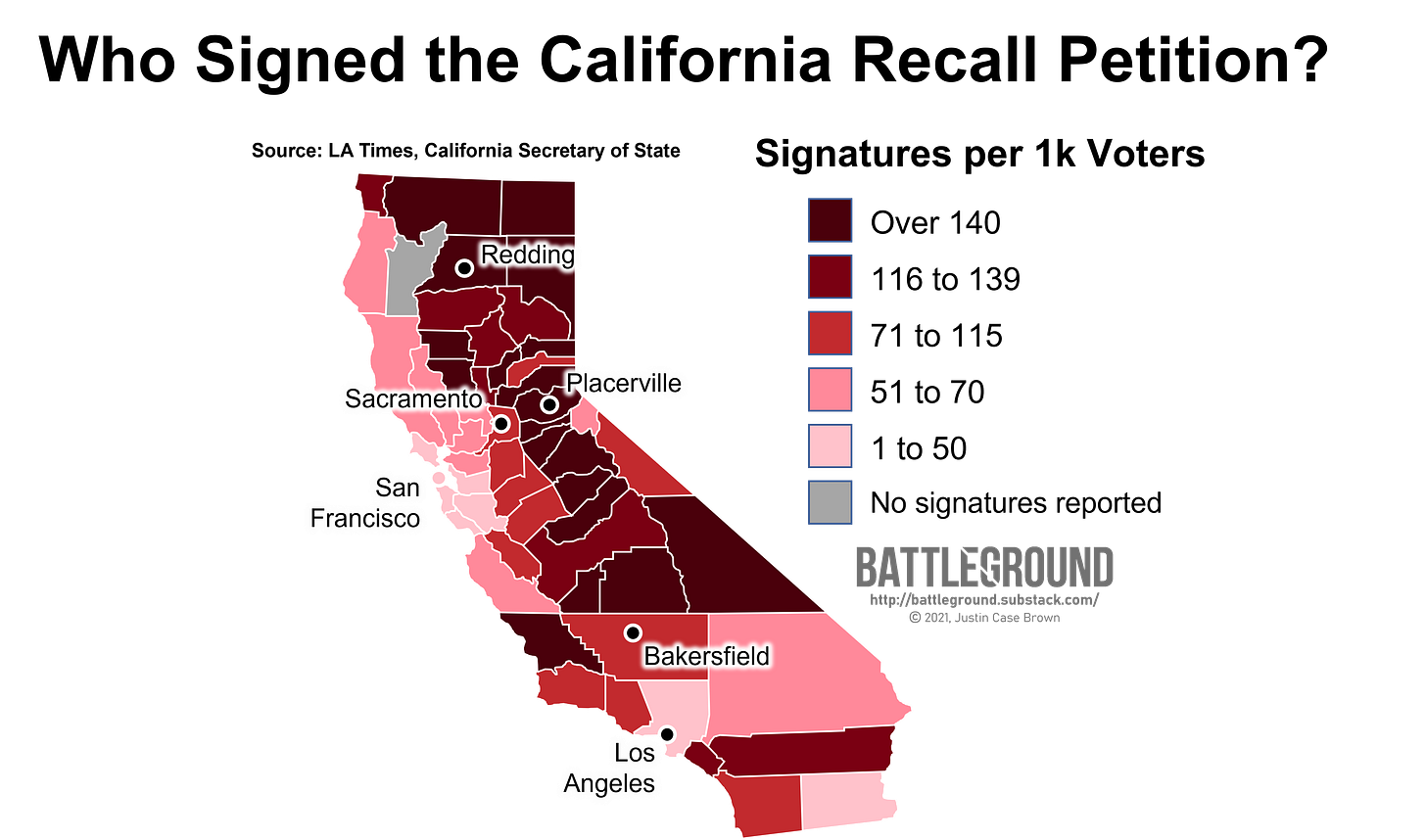The 2021 California Recall (Part 1): How Did We Get Here?
Learn who signed the recall petition that ultimately forced an election in September 2021.
Hello Everyone!
While Election Day is this Tuesday, September 14th, all voters started receiving mail-in ballots nearly a month ago. Assuming results will be ready by the end of the week, the plan is to explain how we got here, examine the candidates on the ballot and explore the vote once the results are released. So let’s first answer the question: How did we get here?
A Brief Timeline1
June 2020: The recall campaign was approved for petition circulation by the California Secretary of State.
Nov 2020: The deadline for submitting signatures was extended to March 17, 2021.
March 2021: Signature deadline passes as organizers submit over 2 million signatures.
May 2021: The California Secretary of State released the final report verifying 1.7 million valid signatures on the recall petition.
July 2021: Lt. Gov. Eleni Kounalakis announced the recall election would take place on September 14, 2021.
July 2021: The final list of certified candidates is released. A total of 46 candidates qualified for the recall, including nine Democrats and 24 Republicans.
The California recall was borne out of a confluence of dissatisfaction. The idea was initially sparked by California voters angered by Gov. Gavin Newsom’s handling of the pandemic. While other large states like Texas and Florida implemented limited restrictions that prioritized the economy over public health, California called for much more lengthy stay-at-home orders and capacity restrictions that caused businesses to close and many residents to lose their jobs. The majority of Californians supported Newsom at the start of the pandemic but his approval rating trended downward the longer he kept these restrictions in place.
Then the recall effort received two shots in the arm in November. First, a judge extended the signature collection period to March 2021 due to pandemic-related restrictions. Second, Donald Trump’s claims of election fraud spread throughout the national Republican party, galvanizing California’s conservative base. As Newsom eased some of California’s pandemic restrictions, the recall was re-framed as a way for angry Republicans to fight back against recent Democratic election wins. Since then, Republicans across the United States have leaned in to the effort, holding rallies and fundraising events to support the effort to oust Gavin Newsom.
While many of California’s most populous counties contributed a large amount of signatures, voters in the state’s Republican strongholds were more heavily represented in the final count of signatures. Most of the counties that were over-represented on the recall petition were counties won by Trump in the state’s more rural counties in the north. A couple of counties in central California, including Fresno, Inyo and San Luis Obispo, supported Joe Biden in the 2020 election and submitted high proportions of signatures compared to their individual electorates. Several counties in southern California, like Orange, Riverside and San Diego also showed surprisingly high support for the recall petition despite being more urbanized areas. This geography provides a closer look at the landscape of voters who are upset with the California Democratic party.
Forecasting the Future: It’s incredibly important to note that signatures don’t tell the whole story, nor are they indicative of Newsom’s chances of being ousted. The threshold to trigger a recall in California is 12 percent of the last total vote for office, currently totaling 1.5 million signatures in a state with over 22 million registered voters. With more than 5.3 million of those voters registered as Republicans, many of whom are energized by Trump’s persistent lies of a stolen election, the petition was pretty much destined to trigger an election. The tricky part for Republicans lies in picking Newsom’s replacement. A whopping 46 candidates ultimately qualified for the recall election, with 24 identifying as Republicans. The election will ultimately ask voters two questions: do you want to recall Newsom, and if so, who would you like to replace him?
While most of the state’s coastal urban areas approve of Gavin Newsom’s job as governor, the recall has exposed the holes in the state’s expansive Democratic coalition. Democrats are using this as an opportunity to repair their standing with these straying coalitions while Republicans are racing to unite these voters behind a formidable candidate.
Leftover Links
Rewind and relive the anger Californians experienced during Gavin Newsom’s pandemic restrictions.
Sneak Peek: The next post will examine the frontrunners in a crowded field to replace Newsom. Familiarize yourself with the official list of candidates.
Abbreviated timeline sourced from Ballotpedia.





Justin, as a Californian, I'd just like to add as to how easy it is to get a recall or a proposition on the ballot, as long as you have money. The law allows for organizations to pay people to gather signatures. Months before an election, it can be impossible to go to a grocery store or shopping center without being beseeched by a person holding a clipboard and a pen seeking your signature. As they are paid commission for each signature, these folks are very motivated to get people to sign petitions.